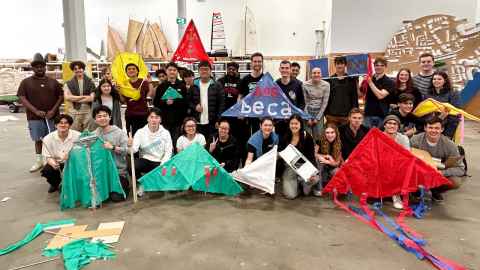Student engineers blow kite judges away
2 October 2023
Flying kites is usually a relaxing pastime. But when you have to build one out of limited materials and get it to fly in a wind tunnel, things get tricky.

Student engineers have been put to the test in the Newmarket Campus wind tunnel.
In September, the Mechanical and Mechatronics Student Association (MECHA) club held its second annual Beca Design and Build Competition at the Campus’s aerodynamics lab, home to the largest wind tunnel in New Zealand. The one-day contest pitted eight teams of four student engineers against each other to see who could design and build a kite using supplied materials, in a short time. Teams competed for a share of the $500 prize pool.
The event was organised and run by MECHA executive member Tiger Fong-Fitzpatrick, a second-year mechatronics engineering student.
“This was the first time we’ve held it in the wind tunnel. The teams of four were given a brief and over the day they built and designed their kites, testing and retesting in the wind tunnel.”
Students made adaptations and then it was crunch time – testing them in the wind tunnel in front of industry judges, including two from engineering firm Beca, who scored their efforts.
MECHA had provided a fictional scenario in which the aim was to design a kite to send a distress signal to Beca. The scenario was that teams would be travelling to a Beca event but find themselves stranded on a desert island.
Flying high at the end of the day were winning team ‘Water Bottle’ (Ruby Chen, Jade Nguyen, Jongyang Zhao and Louis Lee) with a design that withstood every wind-speed scenario. The judges were impressed with the kite’s resilience, lifting smoothly against wind even at the max speed.
Dr Ahmad Zaki, a mechanical engineering alumnus who is now the aerodynamics lab’s senior technician, oversaw its use.
“The tunnel has a 2.5m by 3.6m cross section and is 20m long. It’s a closed-loop tunnel so it loops the wind inside. It’s designed to investigate how wind influences structures, buildings and even ventilation. We use it for other research too, such as wings and aerofoils.
“We’ve also started flying drones inside the tunnel to see how wind affects them.”
William Chea
This story first appeared in the October 2023 edition of UniNews